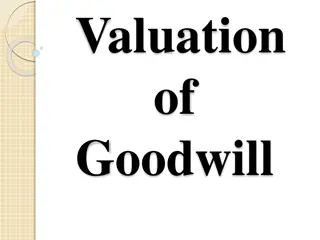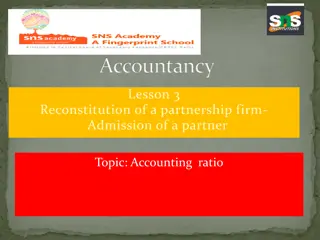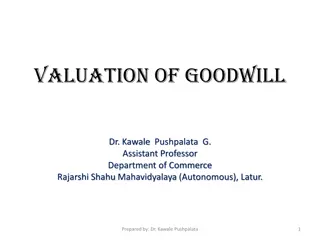Understanding the Significance of Goodwill in Partnership Accounts
Goodwill plays a crucial role in partnership accounts, requiring adjustments during changes in profit-sharing ratios or when partners are admitted, retire, or pass away. It represents the intangible value attributed to a business's reputation and potential for future profits, influenced by factors like nature of business, location, management efficiency, market conditions, and special advantages. Valuing goodwill can be challenging due to its intangible nature, and methods such as the Average Profits, Super Profits, and Capitalisation methods are used to determine its worth in a partnership firm.
Download Presentation

Please find below an Image/Link to download the presentation.
The content on the website is provided AS IS for your information and personal use only. It may not be sold, licensed, or shared on other websites without obtaining consent from the author. Download presentation by click this link. If you encounter any issues during the download, it is possible that the publisher has removed the file from their server.
E N D
Presentation Transcript
Goodwill Goodwill is also one of the special aspects of partnership accounts which requires adjustment (also valuation if not specified) at the time of reconstitution of a firm viz., a change in the profit sharing ratio, the admission of a partner or the retirement or death of a partner.
Meaning of Goodwill Over a period of time, a well-established business develops an advantage of good name, reputation and wide business connections. This helps the business to earn more profits as compared to a newly set up business. In accounting, the monetary value of such advantage is known as goodwill . It is as an intangible asset. In other words, goodwill is the value of the reputation of a firm in respect of the profits expected in future over and above the normal profits. It is generally observed that when a person pays for goodwill, he/she pays for something, which places him in the position of being able to earn super profits as compared to the profit earned by other firms in the same industry. In simple words, goodwill can be defined as the present value of a firm s anticipated excess earnings or as the capitalised value attached to the differential profit capacity of a business . Thus, goodwill exists only when the firm earns super profits. Any firm that earns normal profits or is incurring losses has no goodwill.
Factors Affecting the Value of Goodwill The main factors affecting the value of goodwill are as follows: 1. Nature of business: Afirm that produces high value added products or having a stable demand is able to earn more profits and therefore has more goodwill. 2. Location: If the business is centrally located or is at a place having heavy customer traffic, the goodwill tends to be high. 3. Efficiency of management: A well-managed concern usually enjoys the advantage of high productivity and cost efficiency. This leads to higher profits and so the value of goodwill will also be high. 4. Market situation: The monopoly condition or limited competition enables the concern to earn high profits which leads to higher value of goodwill. 5. Special advantages: The firm that enjoys special advantages like import licences, low rate and assured supply of electricity, long-term contracts for supply of materials, well-known collaborators, patents, trademarks, etc. enjoy higher value of goodwill.
Methods of Valuation of Goodwill Since goodwill is an intangible asset it is very difficult to accurately calculate its value. Various methods have been advocated for the valuation of goodwill of a partnership firm. Goodwill calculated by one method may differ from the goodwill calculated by another method. Hence, the method by which goodwill is to be calculated, may be specifically decided between the existing partners and the incoming partner.
The important methods of valuation of goodwill are as follows: 1. Average Profits Method 2. Super Profits Method 3. Capitalisation Method
Average Profits Method Under this method, the goodwill is valued at agreed number of years purchase of the average profits of the past few years. It is based on the assumption that a new business will not be able to earn any profits during the first few years of its operations. Hence, the person who purchases a running business must pay in the form of goodwill a sum which is equal to the profits he is likely to receive for the first few years. The goodwill, therefore, should be calculated by multiplying the past average profits by the number of years during which the anticipated profits are expected to accrue. For example, if the past average profits of a business works out at Rs. 20,000 and it is expected that such profits are likely to continue for another three years, the value of goodwill will be Rs. 60,000 (Rs. 20,000 3),
Super Profits Method The basic assumption in the average profits (simple or weighted) method of calculating goodwill is that if a new business is set up, it will not be able to earn any profits during the first few years of its operations. Hence, the person who purchases an existing business has to pay in the form of goodwill a sum equal to the total profits he is likely to receive for the first few years . But it is contended that the buyer s real benefit does not lie in total profits; it is limited to such amounts of profits which are in excess of the normal return on capital employed in similar business. Therefore, it is desirable to value, goodwill on the basis of the excess profits and not the actual profits. The excess of actual profits over the normal profits is termed as super profits. Normal Profit = Firm s Capital Normal Rate of Return /100
Firms capital includes partners capital and reserves and surplus but excludes fictitious assets and goodwill. Suppose an existing firm earns Rs. 18,000 on the capital of Rs. 1,50,000 and the normal rate of return is 10%. The Normal profits will work out at Rs. 15,000 (1,50,000 10/100). The super profits in this case will be Rs. 3,000 (Rs. 18,000 15,000). The goodwill under the super profit method is ascertained by multiplying the super profits by certain number of years purchase. If, in the above example, it is expected that the benefit of super profits is likely to be available for 5 years in future, the goodwill will be valued at Rs. 15,000 (3,000 5). Thus, the steps involved under the method are: 1. Calculate the average profit, 2. Calculate the normal profit on the firm s capital on the basis of the normal rate of return, 3. Calculate the super profits by deducting normal profit from the average profits, and 4. Calculate goodwill by multiplying the super profits by the given number of years purchase.
Capitalization Method Under this method the goodwill can be calculated in two ways: (a) by capitalizing the average profits, or (b) by capitalizing the super profits. Capitalization of Average Profits: Under this method, the value of goodwill is ascertained by deducting the actual firm s capital in the business from the capitalized value of the average profits on the basis of normal rate of return. This involves the following steps: (i) Ascertain the average profits based on the past few years performance. (ii) Capitalize the average profits on the basis of the normal rate of return to ascertain the capitalized value of average profits as follows: Average Profits 100/Normal Rate of Return (iii) Ascertain the actual firm s capital (net assets) by deducting outside liabilities from the total assets (excluding goodwill and ficticious assets). Firms Capital = Total Assets (excluding goodwill) Outside Liabilities Where outside Liabilities include both long term and short term Liabilities. (iv) Compute the value of goodwill by deducting net assets from the capitalized value of average profits, i.e. (ii) (iii).























